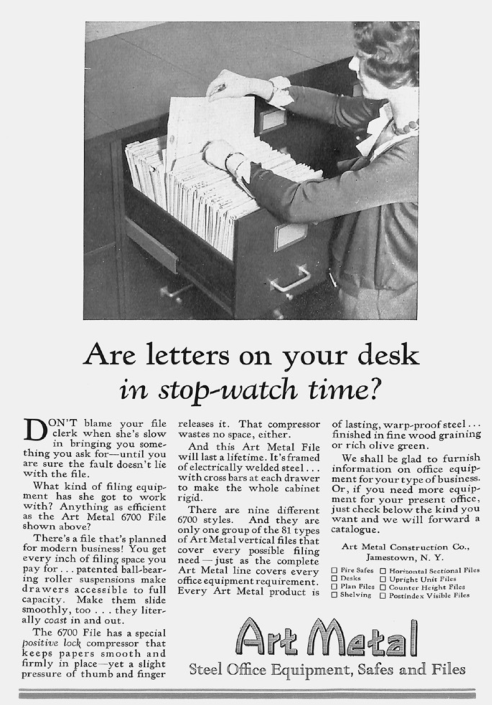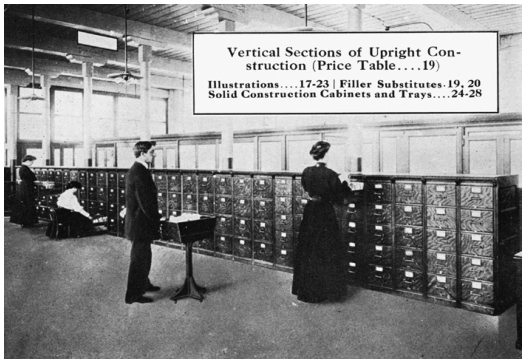created, $=dv.current().file.ctime & modified, =this.modified
tags:informationpaperphysical-media
Thought
Why am I hyped to read a 300+ page book on Filing Cabinets?
The File and Folder metaphor still persists in the “Desktop” environment.
My office has four drawers that I use for holding miscellaneous items. I never really considered them as such, but looking at them more closely, they are in fact shortened filing cabinets.
Of all office items, the filing cabinet seems distinctly archetypical.
The vertical filing cabinet: a rectilinear stack of four drawers, usually made of metal
It’s about: In this book, I examine the affordances of the filing cabinet as an information technology by explicitly considering the relation- ship between power and epistemology. Specifically, I argue that distinctive concepts of storage, filing, information, and efficiency get activated in certain institutional settings to establish social dynamics and relationships, especially those of gender and labor. Two overlapping sets of arguments are critical to this analysis: first, the filing cabinet allows us to understand an important moment in the genealogy of information’s ascendancy; and second, the filing cabinet is an example of the material history of efficiency.
The Efficient Work of Paperwork
Hidden, nondescript: Its ubiquity, along with its absence of style, perhaps paradoxically also contributes to the easy acceptance of the filing cabinet’s presence, which rarely causes comment.
Occasionally the neatness or disorder of a filing cabinet is intended to give viewers an insight into the mental state and work practices of the office’s occupant.
The filing cabinet represents how standardization, rationalization, precision and speed became skills that workers had to master.
manifested through a vertical predisposition (cabinet and skyscraper).
Beginnings
Invented in the 1890s vertical filing cabinets stored large amounts of paper so that individual sheets could be easily retrieved. Loose papers cannot stand upright on their own.
The filing cabinet was a “machine” and one company attempted to lift the status to the telegraph and telephone.

Further quotes
Rigidity - do a hand stand on a loaded Shaw-Walker drawer. Even that will not impair its smooth, silent, speedy action. The slide will still operate as freely as before. It will coast in or out at a touch. Easy Operation - a thin silk thread in the hands of a child will pull the drawer open without breaking, because the drawer starts on roller bearings and not the usual wheels. Light as a feather.
The gendered division of the modern office assigned women to assist men; in contrast, men read the files, doing work understood to require thought.
Filing cabinets were many people’s first encounter with a conception of information as discrete units.
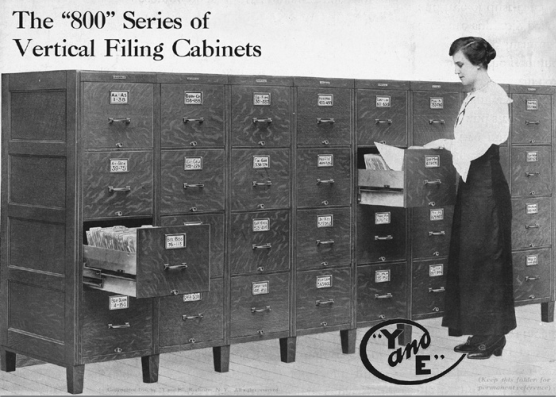 Advertisement: Files… The Treasure Chest of Business
Advertisement: Files… The Treasure Chest of Business
The letter extracted from a file drawer offered a new way of reading.
Computer Files
In 1984, Apple intended that the icons on the screen of its Macintosh computer would make a user’s initial encounter with the technology more comprehensible by making “the manipulation of information in the system analogous to the manipulation of physical objects on a desktop”; this extended the “desktop metaphor” that computer scientists had been using since the 1970s
The Cabinet
The filing cabinet emerged at the same time the skyscraper was becoming a cultural symbol that presented capitalism and modernity as distinctly American projects for the twentieth century.
Skyscrapers profitability was limited by the amount of time it took elevators to reach the higher floors, with elevators in the Woolsworth building traveling twice as a fast as previous ones. Elevator brakes were also important in case the cable broke.
Modular modernity: rel:Book Structures
The modern work environment is made of such modules, each module the same as the next, each made up of smaller modules adapted to an incorporated whole.
Like books: rel:Manicule, Body in Books and Analysis of Love
office floors that had standardized layouts and work- flow systems were found more frequently in books than in buildings.
Work-flows and flows of paper
the office was rethought as a site to facilitate the flow of paper
Thought
I am neat, but my desk is generally a mess.
Followed by belief that: a desk should never be used for storage purposes but should serve as a means for the prompt dispatch of business
Old-style storehouse mode of desk (peak partitioning) was moved to a modern flat-top desk.
In an office … the letters and other business papers ought to flow like a current past all the men who need to use them,” but ultimately they had to flow “right on to the file clerk to be put away for future calls.”
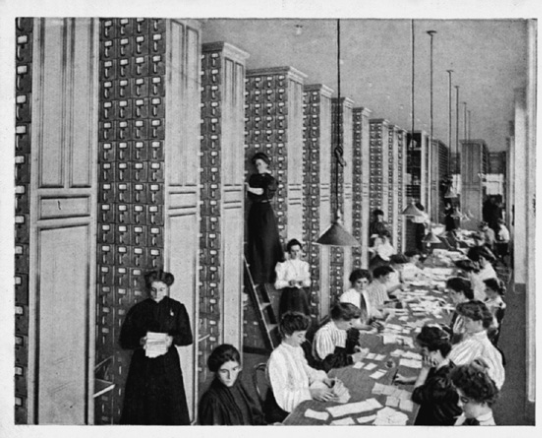
The Integrity
In addition to these more spatial aspects of integrity, the ab- sence of binding raised more temporal concerns related to durability and permanence. Did the filing cabinet offer the same structural integrity as a book?
Ong view of a book as a container/volume where books are things that hold things. The value of the book as a storage technology became its structural cohesion, its wholeness.
Loose-leaf ledgers illustrated the extent legal reasoning had linked material wholeness and moral soundness. Bound paper offered evidence of moral integrity. Loose leaf too easily invited loose behavior.
Thought
Modern documentation systems with timestamps. Logging in medical records.
Two common forms of storage: pigeonhole and spikes.
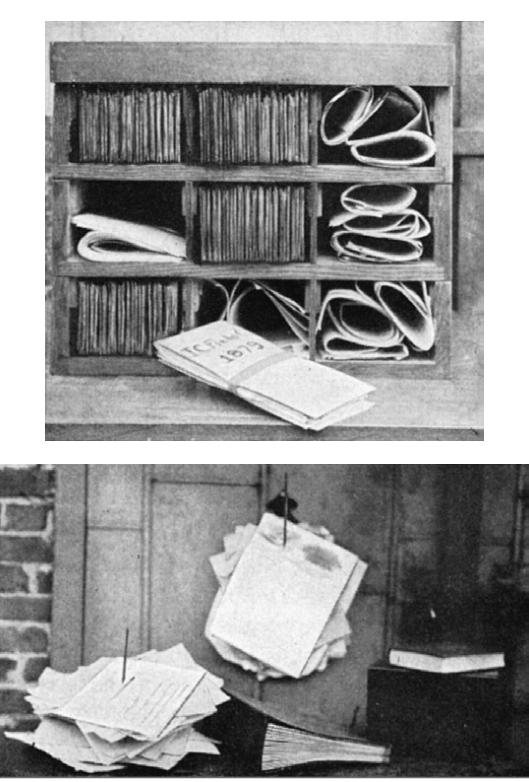
Flat files and Shannon files.
While labels on file drawers or file boxes allowed the fronts of the entire combination of files to be seen at a glance, accessing the files often created problems that threatened the integrity of the cabinet system.
Dust became a problem.
Steel: Steel in its modern form was as new as the office equipment industry itself, and its ascendancy had been far from certain. Eventual domination of steel was the result of a convergence of factors, including scientific research, industrialization, innovation, the tensions between private industry and government policy, the rationalization of factories that produced steel, and the demands of the railroad, building, and automobile industries.
Asbestos was used to protect against fire.
The drawer slide was critical to the promotion of a functional, efficient filing cabinet. Early drawer slides were the sources of a number of problems related to the movement of drawers in and out of steel cabinets. Drawers would fall out of cabinets when pulled out, or rebound into partially open positions when they were closed, or make loud noises when they were closed, as they hit the backs of the inside of cabinets.
Logic
Thought
Logic in cabinets = spatial arrangement of interior. What of exterior arrangements of these logics or multiple cabinets?
Similar to a memory palace. I know with my collection of books, however disorganized they may be, I have a general sense (sometimes even exact) of where a particular book is in the jumble.
The shape and arrangement of the vertical filing cabinet’s interior, its “cabinet logic,” made the cabinet a novel storage technology in the office. Cabinet logic involves the creation of interior compartments to organize storage space according to classification and indexing systems. It connects the filing cabinet to a larger history of storage technologies; this is the history of “orderly furniture” and “intellectual furnishings.”
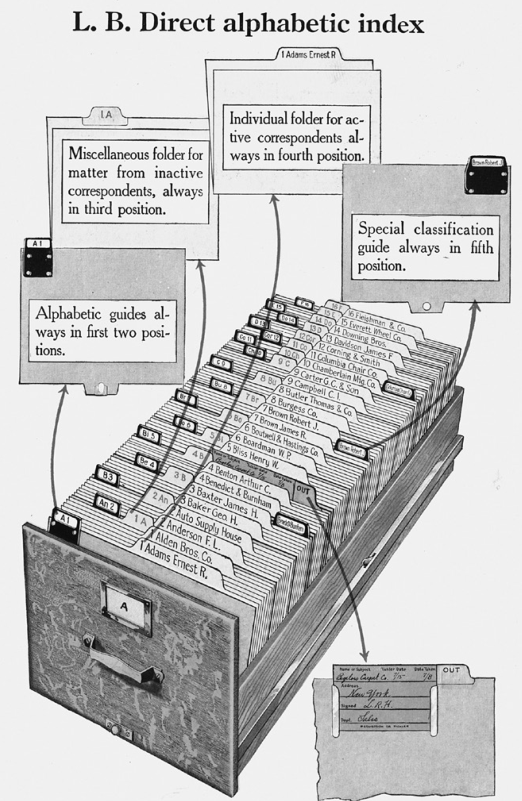 Compressors were used (early a wooden block) to press papers into a smaller volume.
Compressors were used (early a wooden block) to press papers into a smaller volume.
Tabs (particularity)
Advertising and how-to literature did not offer uniform rules on how many guides should be used in a drawer, but some authors gave specific advice, recommending one guide for each inch of filing depth, for example, or fifteen folders per division.
Decaying index: Problems arose as tabs tended to become damaged, dirty, and difficult to read over time, as they were subjected to regular use. Clerks exacerbated both these problems by regularly using tabs as handles when they removed folders from drawers.
Folders (gathering)
rel:Radical Fiber - Threads Connecting Art and Science Jacquard’s Webfiber
Thought
More computing/word/fiber/body connections.
Text, File, Jacquard’s Loom
Further reading: The Guggenheim claims that this creation of manila paper was a way “of recycling manila rope, previously used on ships”. The resulting paper was strong, water resistant, and flexible
On Files: Its name in English comes from techniques to gather paper introduced throughout Europe at the beginning of the fifteenth century. Papers strung on wire or string became known as “files” care of the Latin word filum, meaning string or thread, via the French filer, to spin and thread. Usually the papers that constituted files were secured together by string, rope, or leather straps. Therefore, the file is a technology of gathering that brings a collection of papers together as a unit to be placed somewhere.
Rigorousness: Put simply, a manila folder is a less rigorous form of file. Al- though it provides a place for papers in a drawer, it is not designed to maintain order and produce authority within an institution.
Folders allowed many different sizes of paper to be contained.
An important protection offered by the manila folder was its supposed ability to stop the bogeyman of curled paper.
Filing
Granular Certainty
In the United States paper did not rigorously “define the measure of its surroundings” as it did in Germany, where the A series of paper sizes was adopted in 1922.
Tables meant that statistics no longer had to be embedded in prose.
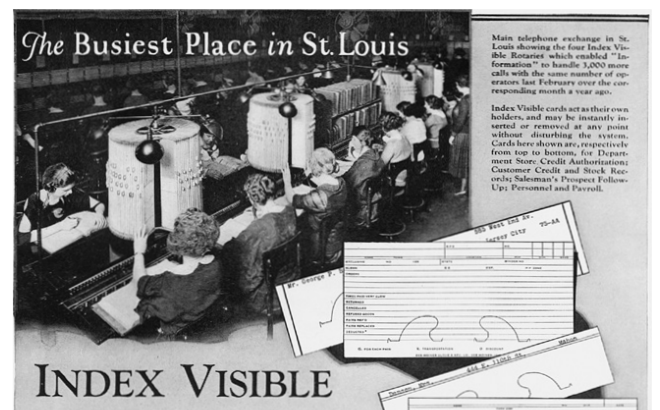
Thought
In English the most frequent letter that starts words is S but I’m not sure if this holds for names (first and last) etc. If we were rebuilding this physical indexing method, would certain groupings swell more than others? Would there ever be a case to enforce even distribution of words? (We aren’t accepting names with the letter J anymore.) You can have an index that puts frequently accessed files into an accessible cache. Can you just ignore the index starting letter group (obvious) and work with other types?
Is alphabetical order obsolete and arbitrary but just accepted?
I was exploring this idea and saw some calls to teach the alphabet “out of order” so that the individuals learned each letter by its unique sound rather than rote memorization and sound (even as an adult I’m aided by sound, and probably would start a song if asked directly an alphabetic order question.)
Automatic Filing - Memory for the Machine
The filing cabinet was explained in terms of a memory or brain that was more reliable than the minds of people, who tended to forget more easily.
The word automatic came into general use in the 19th century derived from the word automaton. Lisa Gitelman argues that the increase use of automatic carried with it lingering connotations of the resolving the organic and mechanical responses of human beings.
A filing cabinet could “remember” because it replaced personal memory with objective procedures, with a system.
NOTE
This spatial memory/forgetfulness is kind of like Places I place my phone.
Is just leaving things in places a kind of memory? How can I leave an event, or an actual memory in a place? Like if I want to save this first kiss or something like that.
What are higher order memories? or memories of memories? or a dense memory or a memory that surrounds itself fully, or a memory all alone? or a memory that is completely disconnected?
With the increased scale and expectations of twentieth-century corporate capitalism, an individual businessman could no longer depend on his memory.
The routine application of classifications in modern offices required “mechanization” and a modern office required application of objective rules on a large scale.
NOTE
Wow!
When mechanized, the association of ideas was no longer a mental connection, a recollection that linked a memory and an object.
That the memory of the filing cabinet was in fact based on procedure and system speaks to the lingering connotations of “human forms and functions built into machinery”
Targeting small- scale businesses with its line of “Desks with Brains,” the compartments are like cells of a the brain, places in which the to systematically file information, ready for instant reference.
Etymology Breaking this down, the latin word Cella was a place-based metaphor for memory. Cella meant storeroom but had other meanings connected it to the use of birds and insects to represent the relationship between the memory and study. the word could refer to both dovecotes and the compartments bees made for honey. An ancient version of the former usage appears in Plato’s dialogue Theaetetus, where pigeons and pigeonholes serve as meta- phors for thoughts and memory
By the medieval period, other spatial metaphors for memory included the wooden chest or box (arca), the money pouch (sacculus), and the let- ter case or book box (scrinium).
The key task was not to learn something by rote but to think by tracking down memories through connections.
As the filing cabinet mechanized remembering, the typewriter mechanized writing.
Advertisements often showed women demonstrating how to use filing cabinets, but the primary role of the file clerks in these advertisements was to model a heterosexual definition of female beauty for the presumed straight male readers of business magazines and trade catalogs
As one manager commented, “I often ask a girl if she plays the piano, or if she knits, crochets, sews, or does another type of work that would enable her to acquire speed with her fingers.
The Ideal File Clerk - Controlling Gender in the Office
From one of the first books published on scientific office management:
File clerks must be rapid and accurate at detail work, attentive to operations which are continually repeated but slightly varied, and must have automatic carefulness in replacing papers. The nature of the activity calls for intelligent and trained women rather than men or boys. Women can handle detail work with more persistent accuracy and patience and with swift, auto- matic expertness. The head of a centralized filing department, however, occupying a position coordinate with that of the other department heads, should preferably be a man
Surveys found that the typical female office worker was a woman in her mid- twenties, likely on her third or fourth office job. On average, she earned $25 per week.
…the anxiety of single women (and men) was conflated with anxiety over paperwork.
Domestic Storage
Moving storage systems from the office to the home.
Older paper storage solutions, often in the form of bound books such as family Bibles, cookbooks, and photograph albums, were in- sufficient for the information demands of twentieth- century society.
Until the end of the nineteenth century, closets were an afterthought in home design. As a storage technology, a closet functions to put storage beyond the edge of a room.
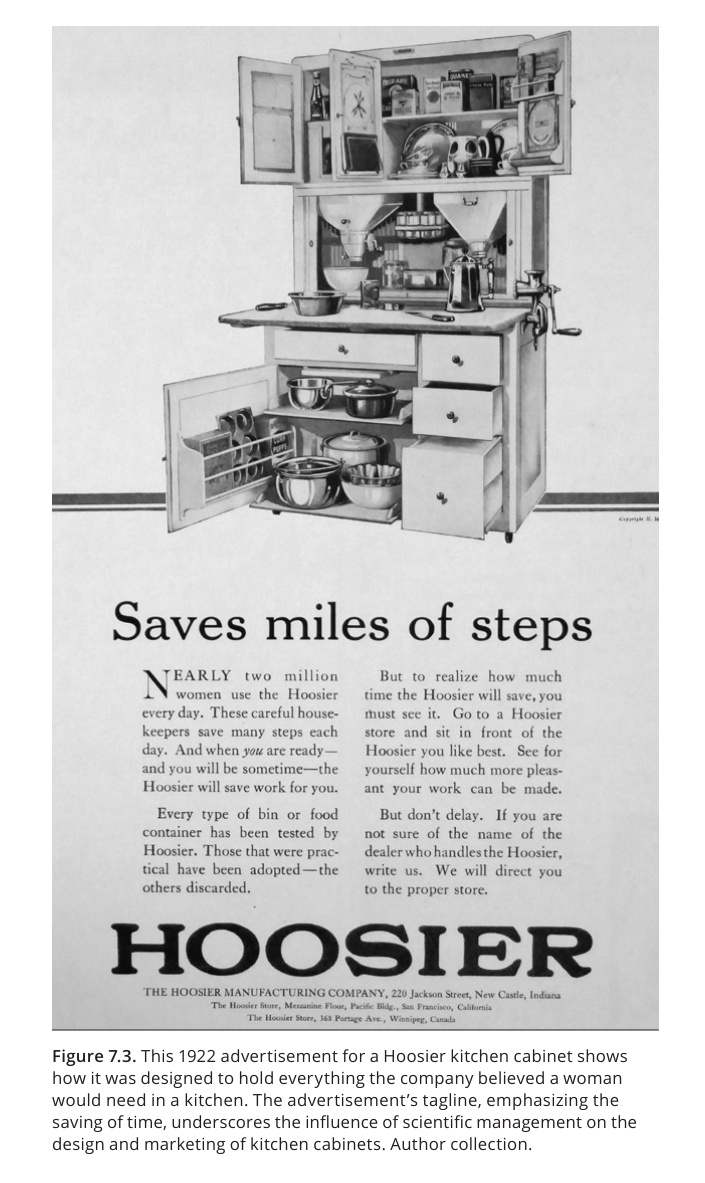
Afterword
When she created it, forty- five- year- old Bren Alvarez in- tended it to satirize and symbolize “the bureaucracy of urban plan- ning.” The thirty- eight file drawers represented the thirty- eight years the Southern Connector road project had been under review.
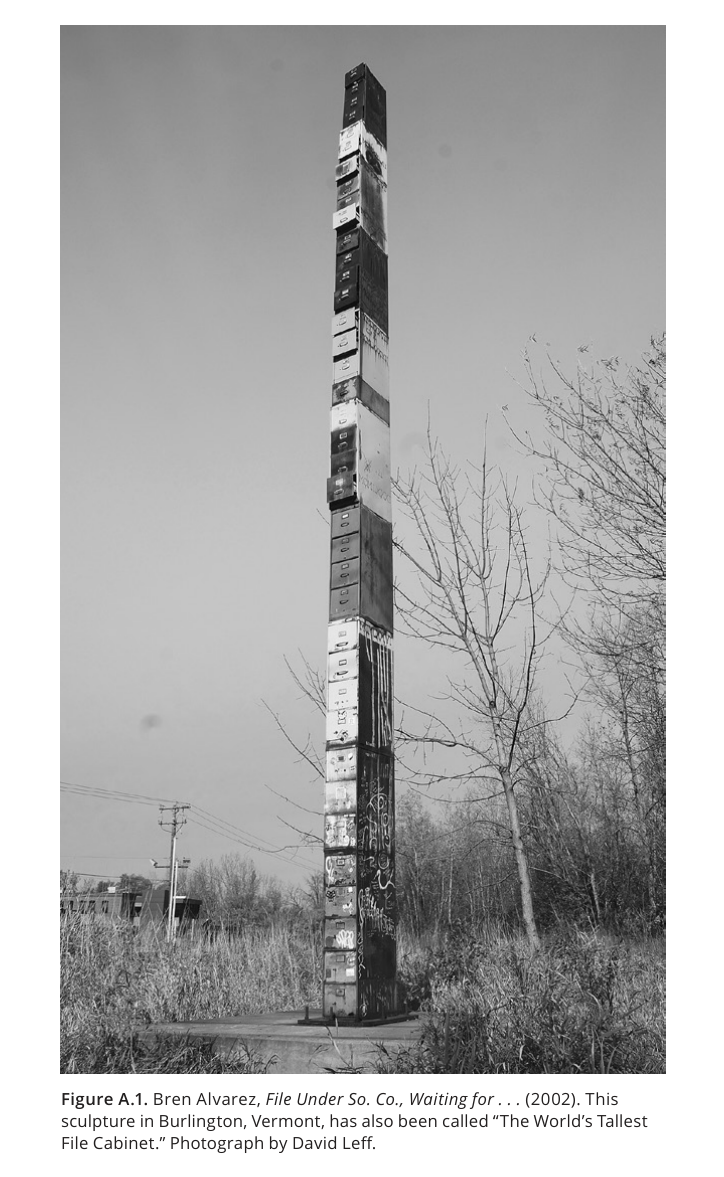
Windows 3.1, released in 1992, included an icon of an open file drawer divided by tabbed folders; two documents partially removed from rear folders made sure that users understood what they were doing when they chose a location to save a document. Therefore, as an icon within a metaphor, the late twentieth- century file cabinet was as efficient as the early twentieth- century filing cabinet.
